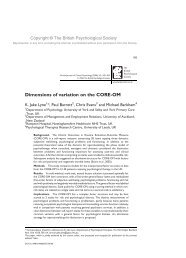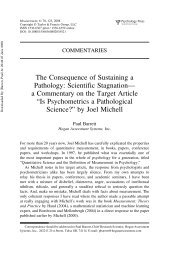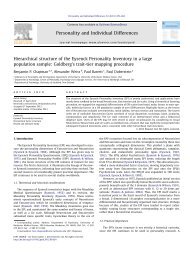Psychophysiological Methods - Paul Barrett
Psychophysiological Methods - Paul Barrett
Psychophysiological Methods - Paul Barrett
- No tags were found...
You also want an ePaper? Increase the reach of your titles
YUMPU automatically turns print PDFs into web optimized ePapers that Google loves.
Breakwell-3389-Ch-08.qxd 2/7/2006 8:49 PM Page 152Pupillary dilation is considered to be indicative of heightened interest andarousal, while electro-oculograms are regularly used in sleep research, for instance,as one indicator of entry to the phase of sleep known as REM (rapid eye movement)sleep, which is characterized by the eyes making rapid darting movements(see Carlson, 2004).ElectrocardiographyPQRST complexsystolediastolesphygmomanometerphotoplethysmograph8.2.4 Cardiac response, blood pressure and blood volumeElectrocardiography refers to the recording of the electrical potentials generated bythe heart muscles over the period of one heartbeat. The electrical waveform producedby the sequence of contractile responses in a heartbeat is referred to as thePQRST complex. The P wave is the small change in potential caused by the initialexcitation of the atrial (upper heart chambers) muscles just prior to their contraction.The QRS complex represents the contraction of the left and right ventricular(lower chambers of the heart) muscles that pump blood from the ventricularchambers to the lungs and rest of the body. The R wave is the point of maximumventricular excitation. The T wave indicates repolarization of ventricular muscle.The term systole is used to describe the atrial and ventricular contraction phases(P–S) and diastole to describe the relaxation phase (T–P) of the passive filling ofthe atria and ventricles. Blood pressure measurement is based upon the measurementof the systolic and diastolic phase wavefronts in the blood moving throughthe arteries. Blood volume measurement (plethysmography) assesses the amountsof blood that are present in various areas of the body during particular activities.To make an electrocardiograph measurement, surface electrodes can be placedon the wrist, ankle, neck or chest. For the measurement of blood pressure, asphygmomanometer (pressure cuff) and stethoscope are used to detect the systolicand diastolic pressures. For blood volume measurements, conventionally aphotoplethysmograph is used to detect the amount of blood passing in tissuedirectly below the sensor (using the principle of light absorption characteristicsof blood). This device is normally placed on a fingertip or an earlobe.The most popular quantitative measures in electrocardiography are of heartrate (counting the number of R waves over a minute) and heart period (the durationbetween R waves). The average heart rate is around 75 bpm, beats perminute which is equivalent to a cardiac cycle of 800 ms, during which the heartis in ventricular systole for 200–250 ms and in diastole for 550–600 ms. However,with a multi-component waveform as in the PQRST complex, and the physiologicalprocesses that underlie the waveform, meaningful measures can be generatedfrom many combinations of latencies or amplitudes between and withinthe PQRST complex. The measurement of blood pressure yields simple pressureindices; however, the ratio between the systolic and diastolic pressure values is ofsignificance, as is the absolute value of each pressure parameter. Normal systolicblood pressure (measured in millimetres of mercury displacement (mmHg))ranges from 95 to 140 mmHg, with about 120 mmHg as the average pressure.152 RESEARCH METHODS IN PSYCHOLOGY












